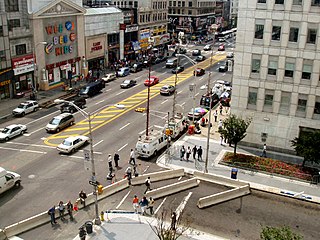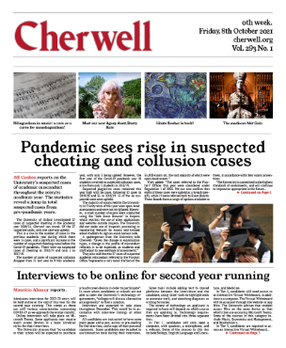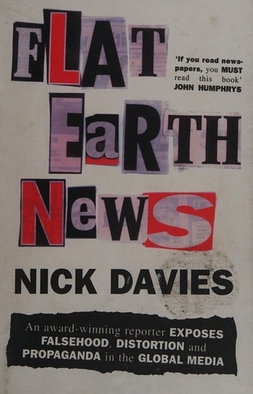
The Economist is a British weekly newspaper printed in demitab format and published digitally. It focuses on current affairs, international business, politics, technology, and culture. Based in London, the newspaper is owned by the Economist Group, with its core editorial offices in the United States, as well as across major cities in continental Europe, Asia, and the Middle East. In 2019, its average global print circulation was over 909,476; this, combined with its digital presence, runs to over 1.6 million. Across its social media platforms, it reaches an audience of 35 million, as of 2016. The newspaper has a prominent focus on data journalism and interpretive analysis over original reporting, to both criticism and acclaim.
News style, journalistic style, or news-writing style is the prose style used for news reporting in media such as newspapers, radio and television.

The news media or news industry are forms of mass media that focus on delivering news to the general public. These include news agencies, newspapers, news magazines, news channels etc.

The Sunday Mirror is the Sunday sister paper of the Daily Mirror. It began life in 1915 as the Sunday Pictorial and was renamed the Sunday Mirror in 1963. In 2016 it had an average weekly circulation of 620,861, dropping markedly to 505,508 the following year. Competing closely with other papers, in July 2011, on the second weekend after the closure of the News of the World, more than 2,000,000 copies sold, the highest level since January 2000.

The Tufts Daily, known on campus as the Daily, is the student newspaper of record at Tufts University in Medford, Massachusetts. The paper covers news, arts and sports both on campus and in the greater Boston area and allows members of the Tufts community to submit opinion pieces about campus, local and global issues. Unlike other student organizations and publications at Tufts, the Daily is financially self-sustaining and does not receive funding from the university.

Cherwell is a weekly student newspaper published entirely by students of Oxford University. Founded in 1920 and named after a local river, Cherwell is a subsidiary of independent student publishing house Oxford Student Publications Ltd. Receiving no university funding, the newspaper is one of the oldest student publications in the UK.
Michael John Connolly was an American magazine reporter and primarily a Hollywood columnist.
The Daily Beast is an American news website focused on politics, media, and pop culture. Founded in 2008, the website is owned by IAC Inc.
Peter Hill is a British journalist and a former editor of the Daily Express.
John Augustine McNulty (1895-1956) was an American journalist and writer. John McNulty is a major figure in the development of the genre of literary journalism.
Katharine Sophie Viner is a British journalist and playwright. She became the first female editor-in-chief at The Guardian on 1 June 2015, succeeding Alan Rusbridger. Viner previously headed The Guardian's web operations in Australia and the United States, before being selected for the editor-in-chief's position.
James Desborough is a show business writer, media commentator and PR consultant who works in Los Angeles, New York and London.
The following outline is provided as an overview of and topical guide to journalism:
The Independent Monitor for the Press (Impress) is an independent press regulator in the UK. It was the first to be recognised by the Press Recognition Panel. Unlike the Independent Press Standards Organisation (IPSO), Impress is fully compliant with the recommendations of the Leveson Inquiry. Impress regulates over 200 titles, consisting of a variety of independent local, investigative and special interest news publications across the UK. No national newspaper has signed up to the new regulator; most continue to be members of the unrecognised IPSO. Its founder is Jonathan Heawood and its current Chief Executive is Lexie Kirkconnell-Kawana.
Everett Lawrence Minard III was an American journalist and the founding editor of Forbes Global, the international edition of Forbes magazine. The Minard Editor Award is named in his honor.

John Morgan Wilson is an American journalist and author of crime fiction, notably the Benjamin Justice mystery novels. The books feature a reclusive ex-reporter, ruined by a Pulitzer scandal and haunted by personal loss, who operates out of West Hollywood West Hollywood, California, becoming enmeshed in murder investigations in and around Los Angeles.

Flat Earth News: An Award-winning Reporter Exposes Falsehood, Distortion and Propaganda in the Global Media is a 2008 non-fiction book by Nick Davies in which he investigating malpractice on Fleet Street. The Flat Earth News is considered to be the sister book to Davies' 2014 publication, Hack attack: the inside story of how the truth caught up with Rupert Murdoch.
Byline Times is a British newspaper and website founded in March 2019 by Peter Jukes and Stephen Colegrave, who are also its executive editors. It is a development of Byline, a crowdfunding and media outlet platform founded in April 2015 by Seung-yoon Lee and Daniel Tudor.
This glossary of journalism is a list of definitions of terms and concepts used in journalism, its sub-disciplines, and related fields, including news reporting, publishing, broadcast journalism, and various types of journalistic media.






